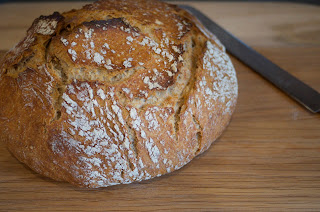 |
| Real American Brownies with a European recipe |
When I make these, I am always asked for the recipe. Here is the problem: they are made with Baker's Unsweetened Chocolate which is not available in the UK. So, with a bit of practice and a few batches, I have converted my Great Aunt Ruth's Brownie recipe to a European friendly version. For my US followers who can get Baker's Unsweetened Chocolate, I have also included the original version:
Aunt Ruth's Brownies - Original version:
2 1/2 oz Baker's Unsweetened Chocolate (2 1/2 wrapped squares)
1/3 cup salted butter
2 eggs, beaten
1 cup sugar
1/2 cup all-purpose flour
1/2 t baking powder
1/8 t salt
1/2 t pure vanilla extract
1 cup chopped nuts, optional
Preheat oven to 325 F / 170C (160 C fan)
Grease and flour a 8" x 8" or 9" x 9" baking pan, or better yet, line it with a piece of parchment paper you scrunch into a ball and then open up to line the pan. Melt chocolate and butter in a double boiler (glass bowl on top of a saucepan with a little bit of slow simmering water below). Let cool, then add the sugar, 2 beaten eggs and the vanilla. Give this a good stir with a fork, let rest for a few minutes and stir it up again. Next, add the flour, baking powder, salt and nuts if desired. Mix together and pour into the prepared pan. Bake for 25 minutes for 8"x8" pan and 20 minutes for 9"x9" pan. The brownies will rise in the pan as they bake, but you need to take them out before the set firmly. Cut into 16 sqaures once cooled. Doubles well for larger batches.
+Abigail Wyckoff notes in the family cookbook that for a richer brownie, use 1 1/2oz unsweetened chocolate and 2 oz bittersweet chocolate.
Aunt Ruth's Brownies - European Version:
70 g 70% dark chocolate
85 g salted butter
2 eggs, beaten
100 g caster sugar
50 g light brown sugar
75 g plain flour
1/2 t baking powder
1/8 t salt
1/2 t vanilla
Preheat oven to 170 C (160 C fan)
Line and grease a square pan with greased baking parchment (teflon sheets are really useful here as well). Melt chocolate and butter in a double boiler (glass bowl on top of a saucepan with a little bit of slow simmering water below). Let cool, then add the sugar, 2 beaten eggs and vanilla. Give this a good stir with a fork, let rest for a few minutes and stir it up again. Add the flour, baking powder, salt and nuts if desired. Mix together and pour into prepared pan. Bake for 25 minutes for 190 cm pan and 20 minutes for 210 cm pan. Cut into 16 squares once cooled. Doubles well for larger batches.
TOP TIP FROM A FOOD STYLIST ABIGAIL WYCKOFF: If you cut the brownies with a cheap plastic knife after they've cooled, you get a nice clean cut.
TOP TIP FROM A FOOD STYLIST ABIGAIL WYCKOFF: If you cut the brownies with a cheap plastic knife after they've cooled, you get a nice clean cut.













































